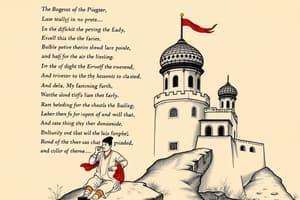Podcast
Questions and Answers
How does the author describe their mother's relationship with language?
How does the author describe their mother's relationship with language?
The author depicts their mother's relationship with language as vibrant and expressive, suggesting that her accent and speech are an integral part of her identity.
What does the phrase 'my mama don't know quiet' suggest about the mother's personality?
What does the phrase 'my mama don't know quiet' suggest about the mother's personality?
It suggests that the mother is lively, outspoken, and unafraid to express herself.
In what ways does the author illustrate the blending of English and Spanish in their mother's speech?
In what ways does the author illustrate the blending of English and Spanish in their mother's speech?
The author illustrates this blending through playful phonetic alterations of words, showing how her speech reflects her cultural background.
What role do hands play in the conversations described in the text?
What role do hands play in the conversations described in the text?
How does the mother's accent serve as a connection to her past?
How does the mother's accent serve as a connection to her past?
Study Notes
Language and Identity
- The mother’s accent is described as powerful, likened to a "shotgun," emphasizing its strength and presence.
- A mix of Spanish and English is used, creating a unique verbal expression that reflects her cultural identity.
- The phrase "sanchocho" suggests a blend, highlighting how cultures can interweave, with language flowing in a non-traditional manner.
Sound and Expression
- The mother's speech is characterized by its liveliness; it fills the space without the possibility of being silenced.
- Mispronunciation and phonetic adjustments show her adaptation to English, transforming "strawberry" into "eh-strawbeddy" and "cookie" into "eh-cookie."
- Her language illustrates a connection to music, with references to Hector Lavoe, indicating the rhythm and emotional depth of her speech.
Cultural Resonance
- The text emphasizes shared experiences among women, with hands symbolizing connection and resilience in communication.
- The use of words like "bomba" and "plena" links her identity to Puerto Rican cultural traditions and celebration.
- Expressions like "wepa" and "dale" foster a sense of community and belonging, turning strangers into family.
Heritage and Legacy
- The mother's tongue serves as a link to her antecedents, containing memories and cultural markers passed down from her mother.
- Nature sounds, like the "coqui," reinforce her connection to heritage and the environment of her roots.
- Her struggle with English reflects a broader narrative of immigrants navigating language barriers while holding onto their cultural voice.
Studying That Suits You
Use AI to generate personalized quizzes and flashcards to suit your learning preferences.
Description
Explore the expressive power of language and identity in this poetic text where the author's mother embodies a vibrant mix of cultures. Delve into the significance of voice and the refusal to be silenced, highlighting the dynamic interplay of English and Spanish. This quiz will enhance your understanding of cultural expression and personal agency in communication.




